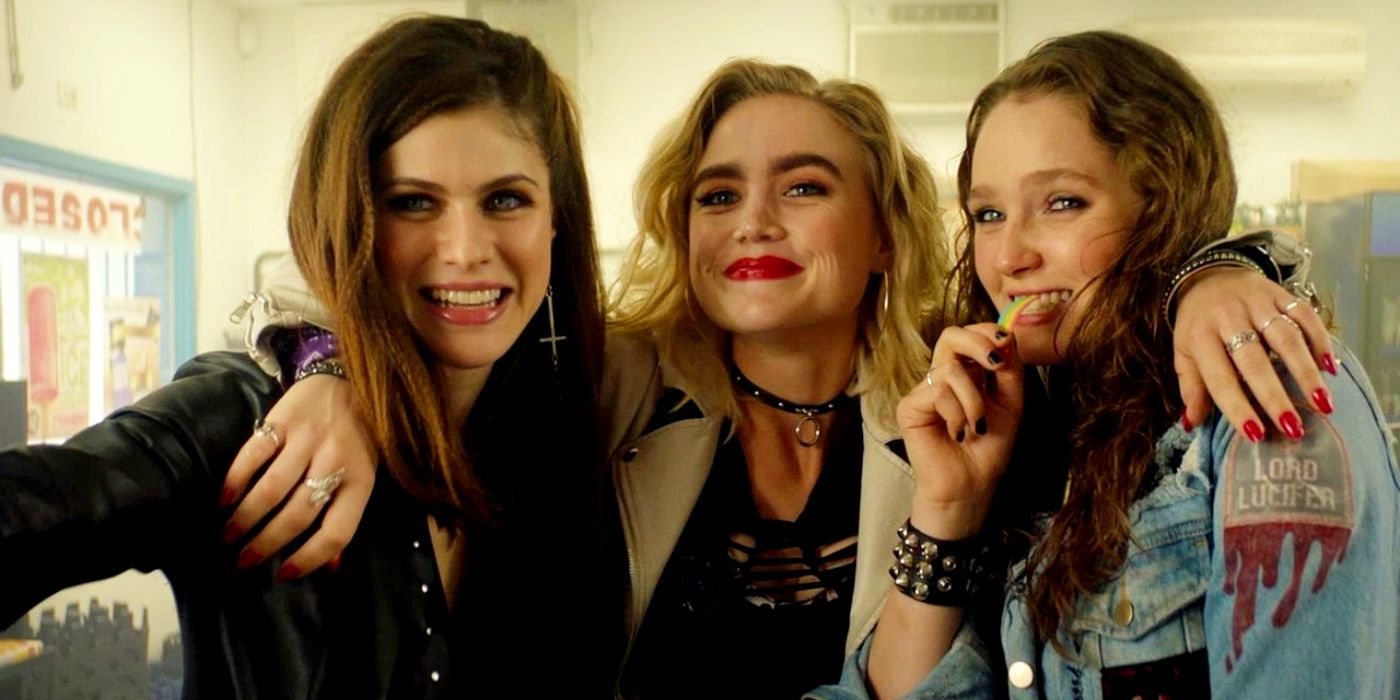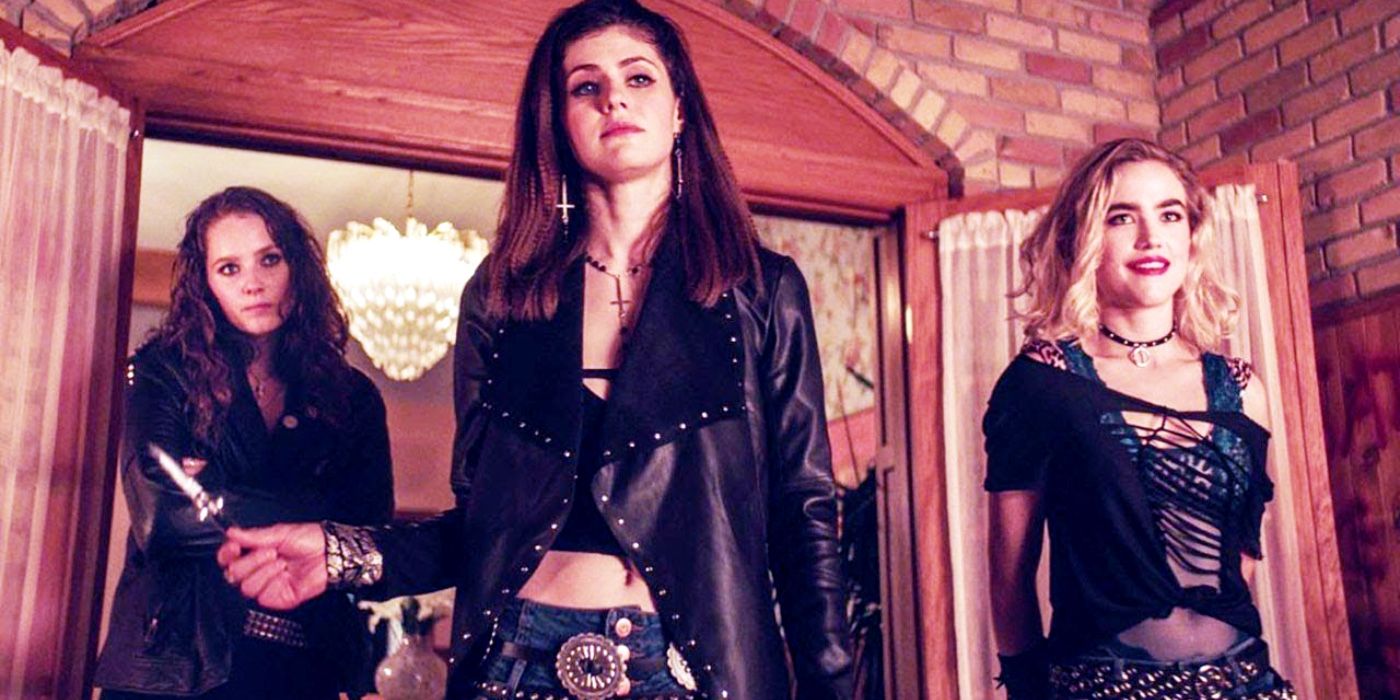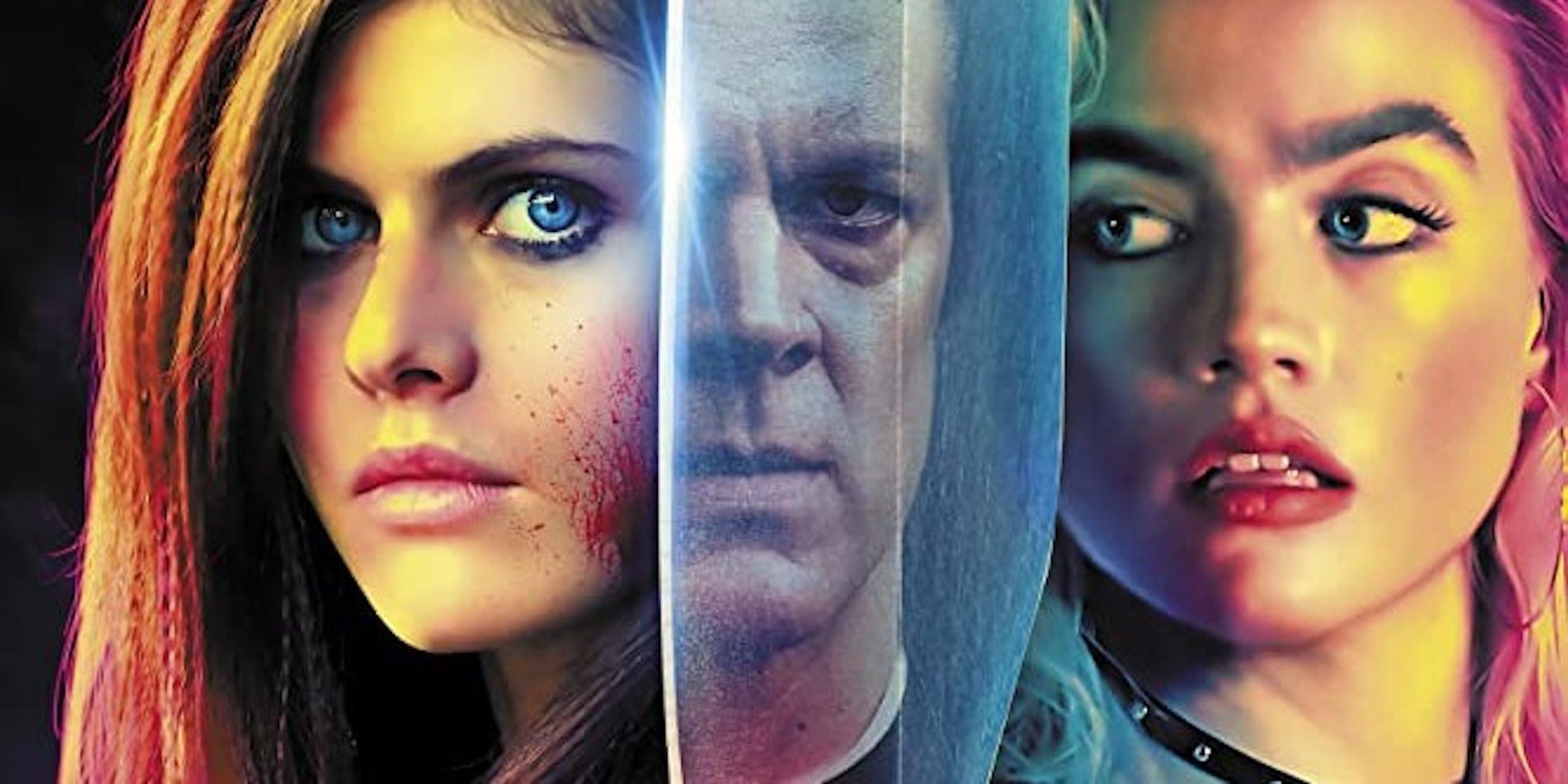
WARNING! Spoilers for We Summon the Darkness below.
Director Marc Meyers (My Friend Dahmer) explores a female-led account of the 1980s' "Satanic Panic" in We Summon The Darkness, which delivers two major twists that subvert the horror movie's sub-genre in a big way.
Originally premiering at 2019 film festivals, We Summon the Darkness released on VOD in April 2020, then on Blu-Ray and DVD in June 2020; the film got a new audience from its Netflix release in August 2020. Starring Alexandra Daddario, Keean Johnson, Maddie Hasson, Logan Miller, Amy Forsyth, and Johnny Knoxville, the horror movie adds some fresh content for at-home audiences when the state of many theaters in the United States is still unknown, due to the Coronavirus pandemic. Though its reception was mixed from critics and audiences, the movie plays to its strengths and manages to continually entertain through its aesthetic, dark humor, and talented cast.
Recently, the 1980s have been a popular trend in horror, with movies such as Summer of '84 and season 9 of American Horror Story exploring the decade. We Summon the Darkness plays into this by leaning into the "Satanic Panic" of the era, which is another commonly explored trend in horror with an '80s bend; Meyers' movie smartly adds a few twists that even seasoned horror fans might not see coming.

Seeking to capitalize off the rising fear of "Satanic Panic", the three friends—Alexis, Val, and Bev—turn the tables on their male cohorts by drugging their drinks after a heavy metal concert, tying them to chairs, and putting them in a room that's heavily decorated with stereotypically Satanic imagery. Though the beginning of the movie makes it seem like the girls are maybe just a little misguided or leaning into their wilder sides for a phase, and puts the boys in a position where they might be predatory, this is flipped on its head by the movie's mid-point.
Before the girls drug the three male friends—Mark, Kovacs, and Ivan—Bev (Forsyth) expresses concern that one of them has a switchblade. This is a clever diversion, adding to the audience's fears that maybe the young men will do what many young men do in horror movies—prey upon or ritualistically sacrifice the girls. However, the girls being the true villains of We Summon the Darkness is foreshadowed early—and subtly—by a news story on the radio while they're on their way to the concert that discusses a recent string of eighteen murders that have happened across the country; due to the nature of the killings, they were all connected to Satanists.
Given that heavy metal music and Satanism is often connected, the girls meeting these boys at this concert adds to the arising suspicion that someone is going to be the victims of whoever is responsible for these killings. There are brief moments where it seems like the girls could be the villains of the story, as the boys are sort of goofy and innocent, but the bigger twist is that they're not actually killing to appease the Devil at all—they're Christians. Alexis, Bev, and Val are trying to bring people who have lost their way back to God. By playing into the panic associated with Satanism, it's their hope that people will start to fear for their immortal souls and find their way back to the church.
From here, We Summon the Darkness cleverly sends the audience down another rabbit hole by making them think that the girls are responsible for all of the Satanic-branded murders that have been going on recently. Even the boys, tied to chairs and fearful for their lives, make this assumption, which adds to overall efficacy of a lightbulb moment. It's convincing—they barely reacted to the news story, they have motive, and they're clearly committed to following through, as if they've done it before. The way they lured the boys into a game of Never Have I Ever and teased that they drugged their drinks, letting them slowly come to the realization—and shock—that they were being preyed upon didn't seem like an amateur move. However, the movie reveals a second twist.

Not only are the girls Christians, but they're working with the church that was briefly mentioned on the TV at the convenience store the girls went to at the beginning of the movie. Called The Daughters of the Dawn, the church—which really seems more like a cult—is responsible for the murders that have taken place, which explains why they're scattered around. As Alexis (Daddario) outlines for their would-be victims, it's their group's "turn" to do a killing, and after them, there will be another, and another, and so on. It's apparently some kind of bigger mission for the church, which goes along with their bigger motivation. Widespread panic is an effective way of controlling a society, and sociological terms such as "culture of fear" suggest that creating fear can be utilized to help achieve political goals as well; if a population is looking for answers out of fear and someone—whether it be a charismatic religious leader or politician—offers a way out or a plan for salvation, some are likely to fall in line and take the bait.
After murdering one of the boys, the other two hole up in another room while Alexis and Val (Hasson) try to figure out how to get them out so they can finish what they started. A rather humorous interaction with both Alexis' stepmother and the sheriff—which quickly escalates to violence—hints at the movie's final twist. Alexis is strangely concerned about her father finding out about what's going on at the house. It's a safe assumption that she's worried he'll be rightfully upset about her murdering people in his house; this could easily lead to them going to jail. Alexis kills her stepmother and Val kills the sheriff, but there still seems to be a looming fear that Alexis' dad will show up and bust them.
When Alexis' father arrives, it's revealed that he is John Henry Butler (Johnny Knoxville), the pastor and leader of The Daughters of the Dawn. Because of this, Alexis' fear wasn't that he'd find out what she was doing, but rather that he'd think her incapable of doing something for their church; she didn't want to be a disappointment. Sure enough, she ends up getting a very parental lecture from her father, who helps her clean up her mess. However, Bev—a runaway they picked up to indoctrinate into the church—doesn't have the same vested interest in their mission, and ends up being their undoing.
The ending of We Summon the Darkness sees Bev and Mark escape. Butler gives an interview to news reporters about the grisly scene at his home, which involved his daughter, and lies about her affiliation, citing that she was with Satan; he feigns regret for not saving her. His decision to save face makes it seem like he's far more interested in the preservation of his mission than he ever was concerned about his own daughter, which is a key trait of many cult leaders, such as Charles Manson. While it's possible that Bev and Mark (Johnson) could cause trouble for the pastor down the road and even expose him, it doesn't seem like they're interested in pursuing him. Rather, they just seem grateful to be alive.
https://ift.tt/2XLmcmi
August 10, 2020 at 05:00AM




